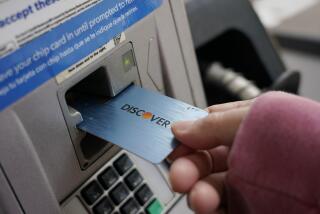Americans missing fewer loan payments, banking group says
- Share via
A leading bank trade group said Americans are making headway in cleaning up their finances, with borrowers missing fewer payments on credit cards and other consumer loans in the first three months of the year — the third straight quarterly decline.
Delinquency rates also fell for home equity loans and credit lines in the first quarter, according to an analysis released Wednesday by the American Bankers Assn. It was the first quarter that home equity loan delinquencies had fallen in two years, an encouraging sign, said James Chessen, chief economist for the banking trade group.
“I think it’s a very good thing that consumers are reducing their obligations and saving more,” Chessen said.
Overall, the rate of missed payments on consumer loans declined for the third straight quarter, the ABA said in its quarterly Consumer Credit Delinquency Bulletin. The composite ratio, which tracks delinquencies in eight installment loan categories, fell to 2.98% from 3.19% in the final quarter of 2009.
Credit card delinquencies, which the ABA defines as loans on which at least one payment has been missed, fell to 3.88% from 4.39% of all accounts, the first time since 2002 that card delinquencies fell below 4%.
Delinquencies on home equity loans fell to 4.12% from 4.32% the previous quarter. The loans, which are second mortgages, differ from home equity lines of credit in that borrowers can’t withdraw more money once the loan has been made.
Delinquencies on home-equity-linked credit lines fell to 1.81% in the latest survey, down from 2.04% in the final quarter of 2009 and a peak of 2.12% in the third quarter last year. Applications to refinance home loans jumped by 9.2% last week, the highest level in nearly 14 months, the Mortgage Bankers Assn. said in a separate report. With mortgage rates near record lows, refinancing can allow homeowners to lower their monthly housing costs.
However, the mortgage group’s index of applications to buy homes declined 2% from the previous week. The index has fallen in eight of the last nine weeks, reflecting the end of federal tax credits for home buyers at the end of April. Economists are hoping purchase lending may revive by the end of this summer, signaling a fundamental improvement in housing.
“Maybe we’re starting to see an inkling of stability in the housing market,” Chessen said. “The pace, though, of the housing recovery is still going to be very long and drawn out.”
Chessen said banks are now looking to make new loans — as long as the borrowers’ credit ratings are solid. But he acknowledged that lending standards remain very tight after years of heavy losses on consumer loans and more expected losses to come on commercial real estate loans.
He added that consumers aren’t likely to go on another spending spree. So what’s good for their personal finances — debt reduction and savings — will continue to restrain the economy.
“The banks are putting losses behind them and looking to replace the bad loans with good loans that perform very well,” he said. But “it’s going to take many years to work down the unemployment rate and create new jobs.”
Paul Kasriel, Northern Trust Bank’s chief economist, agreed that the trends were favorable and indicated that banks were getting some of their consumer loan troubles under control. But he warned that more troubles are in store for lenders and their business clientele as underwater commercial mortgages come due over the next few years.
He added that many consumers, rather than voluntarily reducing their spending, are probably finding it impossible to get new credit from the banking industry.
“I think it’s more along the lines of lenders saying they don’t like the look of your personal balance sheet anymore,” Kasriel said.
More to Read
Inside the business of entertainment
The Wide Shot brings you news, analysis and insights on everything from streaming wars to production — and what it all means for the future.
You may occasionally receive promotional content from the Los Angeles Times.











